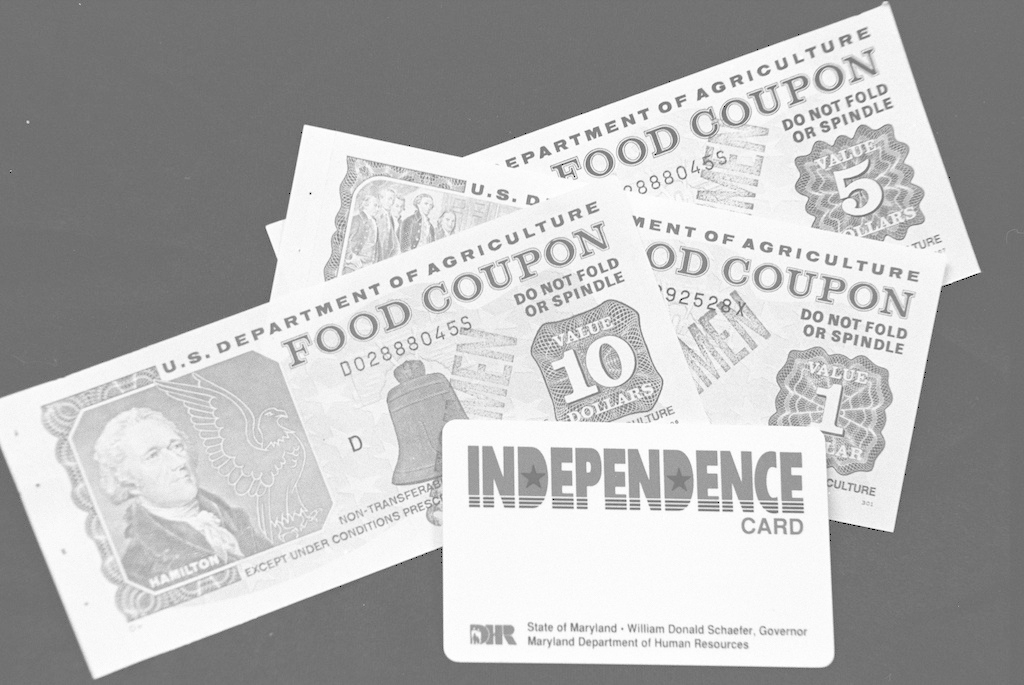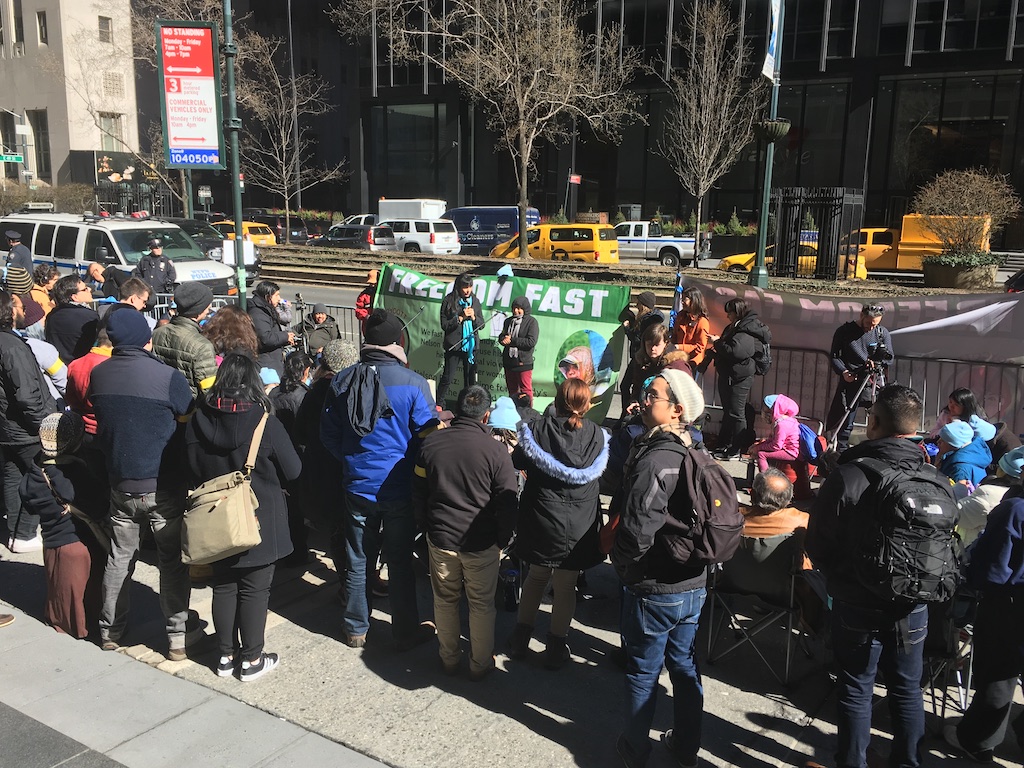In July of 2016, as he gave his speech accepting the Republican presidential nomination, Donald Trump used the opportunity to paint a bleak portrait of present-day America—and gave an aspect of food policy a rare mention, if only in passing. “President Obama has almost doubled our national debt to more than $19 trillion, and growing,” he said. “Yet what do we have to show for it? Our roads and bridges are falling apart, our airports are in third-world condition, and 43 million Americans are on food stamps.”
The SNAP (Supplemental Nutrition Assistance Program, formerly known as “food stamps”) program makes for particularly useful political fodder: it can be offered up as evidence for pretty much any argument, depending on how favorably (or not) you view the program. For one legislator, high participation numbers help tell the story of empty cupboards in the land of plenty. For another, they’re a sign of entitlement run amok.
And so it’s perhaps not surprising that SNAP has made its way into our highly charged national debate about immigration. In some ways, the program has become collateral damage in ongoing arguments about the presence (and plight) of undocumented workers.
See, for instance, a case study in contrasting headlines. In March of this year, Caitlin Dewey wrote a piece for The Washington Post titled “Immigrants are going hungry so Trump won’t deport them.” In the piece, Dewey talked to the SNAP outreach coordinator for a Tennessee food bank, who said that her working immigrant clients are too fearful, in the current political climate, to take advantage of the program. “She’s being asked to explain how food stamps may impact immigration status, if not to outright cancel family food benefits,” Dewey wrote.
In 2016, across the digital aisle, the conservative news and commentary website CNSNews.com ran with this headline: “Report: Some Illegal Aliens Enjoy Food Stamp Advantage Over U.S. Citizens.” citing a Center for Immigration Studies (CIS) report that showed SNAP “provides benefits to families with an illegal alien (or other ineligible alien) wage earner in it, while denying benefits to an identical family comprised of only U.S. citizens.” (It’s worth mentioning that the Southern Poverty Law Center added CIS to its hate-group list in February of 2017. PolitiFact’s take on the designation: “We found the case against the center is based on some of its associations rather than its current work. But we want readers to review the evidence for themselves.” Have at it here.)
Regardless of your stance on immigration policy, the law is clear: undocumented workers both are and aren’t allowed to take part in SNAP. On an individual level, USDA eligibility guidelines make clear that benefits are available only to “U.S. citizens and certain lawfully present non-citizens.” But though SNAP eligibility is assessed at the individual level, benefits are disbursed at the household level. This means that when a U.S. citizen successfully applies for the program, their family members cannot be denied benefits because of immigration status. That way, a son could provide SNAP to his undocumented parents, for example, or a mother to her undocumented spouse and child.
But how often is that actually happening?
Farmworkers pick squash in Mechanicsville, Virginia
A new study out of the University of California Davis may have some answers that get beyond the ideology. Researchers there found that, among the farmworker population, immigrants are significantly less likely to use SNAP. The finding could be critical ammunition for those fighting the common assumption that immigrant crop workers (especially Hispanic crop workers) burden the U.S. economy by utilizing SNAP more than citizens.
Dr. Paul Leigh, a professor with the Department of Public Health Sciences and Center for Healthcare Policy and Research at UC Davis, together with with co-author Alvaro Medel-Herrero of the UC Davis Center for Health and the Environment, wanted to develop a clear picture of SNAP participation among U.S. farmworkers, focusing on the recession years following the financial crisis of 2007-2008, when participation in general saw an uptick.
Using the National Agricultural Workers Survey of the U.S. Department of Labor (DOL), which contains demographic, employment, immigration and health information on crop workers, including SNAP use or nonuse, Leigh and Medel-Herrero found that, in roughly 18,000 households from 2003 through 2012, undocumented farmworker immigrants were 43 percent percent less likely to participate in SNAP than households headed by non-Hispanic white citizens with the same need, as determined by poverty level and number of children. Documented farmworker immigrants were 40 percent less likely.
They also found that farmworkers who were Hispanic citizens were 30 percent less likely to participate in SNAP than non-Hispanic white citizens with the same poverty status and number of children.
Here’s what’s most interesting about the data analyzed by the study: there’s simply not much else out there. “It’s very difficult to find data on undocumented workers,” Leigh tells me. “There are very few national data sets with any information on undocumented immigrants within any industry—or even any undocumented people, whether or not they are working.” DOL stats on farmworkers are a rare exception: “These data are really terrific because they’re from the Department of Labor and are able to identify who [on SNAP] is or isn’t undocumented,” Leigh says. The findings here help make a clear case for “more national data on documented and undocumented workers, so we can speak with some authority … about abuse of food stamps.”
But in some ways—and this gets a little esoteric, so bear with me—that very absence of data is a useful way to refute claims that immigrant farm laborers are somehow gaming the system. If we don’t really know how many undocumented workers there are and how much they’re using SNAP, who can prove they’re benefitting more than citizens?
Lack of accurate data can cut both ways when you need it to spin a political narrative. Anti SNAP-ers could just as easily argue that their concerns about abused entitlements can’t be disproven by the numbers.
For the researchers, the agenda is simpler. They say they hope their study can help secure the future of SNAP, which was expanded following the economic crisis but is currently being considered for sharp cuts. And they also hope additional research identifies ways to address barriers to utilizing SNAP among eligible nonusers.
“The studies show that it’s a cost-effective poverty program,” says Leigh. “It’s hard to say that’s something that’s not particularly useful for people to live.”










